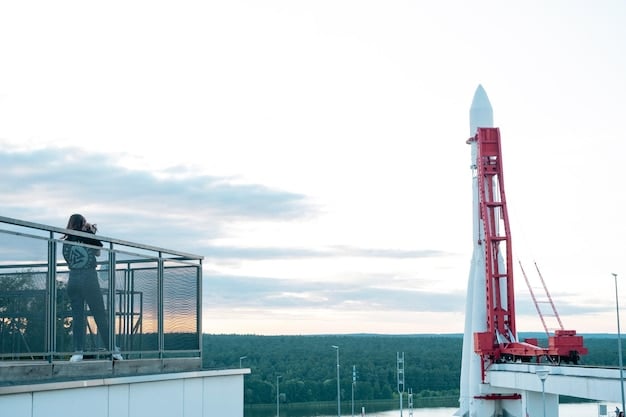How NASA’s Artemis Program Impacts Space Exploration for US Citizens

NASA’s Artemis Program is driving the future of space exploration for US citizens by aiming to return astronauts to the Moon, fostering technological advancements, creating economic opportunities, and inspiring a new generation interested in science and space travel.
The NASA’s Artemis Program shaping the future of space exploration for US citizens marks a pivotal moment, heralding a return to the Moon and paving the way for future missions to Mars. This ambitious endeavor not only aims to expand our scientific understanding of the cosmos but also promises to inspire, innovate, and create opportunities for generations to come.
The Goals of the Artemis Program
The Artemis Program represents more than just a return to the Moon; it’s a strategic initiative designed to establish a sustainable presence on the lunar surface. This ambitious project encompasses a range of goals that will shape the future of space exploration for the United States.
Returning to the Moon
At its core, Artemis aims to land astronauts, including the first woman and person of color, on the Moon by 2025. This mission isn’t just a symbolic achievement; it’s a critical step in preparing for future missions to Mars.
Establishing a Sustainable Lunar Presence
Unlike the Apollo missions, Artemis seeks to create a long-term presence on the Moon. This includes developing infrastructure, technologies, and resources that will enable sustained exploration and research.

Preparing for Mars
The Moon serves as a testing ground for technologies and capabilities needed for future Mars missions. By learning how to live and work on the Moon, NASA can refine its approach to deep-space exploration.
- Sustained presence: Establishing a continuous human presence on the Moon.
- Resource utilization: Learning to extract and use lunar resources like water ice.
- Technology development: Testing and refining technologies for deep space travel.
The Artemis Program sets ambitious goals that extend beyond merely revisiting the Moon. By establishing a sustainable lunar presence and preparing for Mars missions, NASA aims to lead the way in the next era of space exploration.
Technological Advancements Driven by Artemis
The Artemis Program is a catalyst for innovation, driving significant advancements in various technologies. These developments not only support lunar exploration but also have broader applications for life on Earth.
Next-Generation Technologies
Artemis relies on cutting-edge technologies to achieve its goals, ranging from advanced spacecraft to innovative life support systems.
Space Launch System (SLS)
The SLS is the most powerful rocket ever built by NASA, designed to send astronauts and heavy cargo to the Moon and beyond. Its development represents a significant leap in launch capabilities.
Orion Spacecraft
Orion is a crew module designed to carry astronauts on deep-space missions. It incorporates advanced life support systems and is designed for long-duration space travel.
- Advanced materials: Developing lightweight, durable materials for spacecraft.
- Robotics: Creating robots for lunar exploration and resource extraction.
- Communication systems: Enhancing communication technologies for deep-space missions.
The technological advancements spurred by the Artemis Program are essential for achieving its ambitious goals. These innovations will not only enable lunar exploration but also have far-reaching implications for various industries and scientific fields.
Economic Opportunities Stemming from the Artemis Program
Beyond its scientific and technological contributions, the Artemis Program is creating numerous economic opportunities for US citizens and businesses. The program’s investments are driving job growth, fostering innovation, and stimulating economic activity across various sectors.
Job Creation
The Artemis Program supports thousands of jobs across the United States, from engineers and scientists to technicians and manufacturing workers. These jobs contribute to the growth of the aerospace industry and related sectors.
Commercial Partnerships
NASA is partnering with private companies to develop and provide technologies and services for the Artemis Program. These partnerships are fostering innovation and creating new business opportunities.
- Aerospace manufacturing: Increased demand for spacecraft components.
- Technology development: Opportunities for startups to innovate in space technologies.
- Resource extraction: Potential for commercial lunar resource extraction.
The economic benefits of the Artemis Program extend beyond the aerospace industry, creating jobs and opportunities in various sectors. These economic contributions reinforce the program’s value to US citizens and the nation as a whole.

Inspiring the Next Generation of STEM Professionals
One of the most significant impacts of the Artemis Program is its ability to inspire and engage the next generation of STEM (Science, Technology, Engineering, and Mathematics) professionals. By showcasing the excitement and potential of space exploration, Artemis is encouraging students to pursue careers in these critical fields.
Educational Programs
NASA is actively involved in educational programs that use the Artemis Program to teach students about science, technology, engineering, and mathematics. These programs aim to inspire a passion for STEM and prepare students for future careers in these fields.
Engaging Students
The Artemis Program provides opportunities for students to participate in hands-on activities, research projects, and internships related to space exploration. These experiences can spark an interest in STEM and provide valuable skills for future careers.
Public Outreach
NASA’s public outreach efforts related to the Artemis Program aim to engage and educate the public about the wonders of space exploration. These efforts include websites, social media, events, and media appearances.
- STEM education: Encouraging students to study science, technology, engineering, and mathematics.
- Career opportunities: Highlighting the diverse career paths in the aerospace industry.
- Inspiration: Sparking a passion for space exploration among young people.
The Artemis Program is playing a critical role in inspiring the next generation of STEM professionals. By engaging students, providing educational opportunities, and showcasing the excitement of space exploration, Artemis is helping to build a skilled workforce for the future.
The Role of International Collaboration in Artemis
The Artemis Program isn’t solely a US endeavor; it involves significant international collaboration with partner nations around the globe. This collaboration enhances missions, distributes costs, and fosters goodwill.
International Partnerships
NASA is working with space agencies from countries such as Canada, Europe, and Japan to develop and implement the Artemis Program. These partnerships involve sharing resources, technologies, and expertise.
Shared Goals
International partners are contributing to various aspects of the Artemis Program, including the development of the Lunar Gateway, lunar landers, and scientific instruments. These contributions reflect a shared commitment to advancing space exploration.
- Resource sharing: Pooling resources to support ambitious space missions.
- Expertise exchange: Sharing knowledge and expertise among international partners.
- Global cooperation: Fostering international cooperation in space exploration.
International collaboration is essential to the success of the Artemis Program. By working together with partner nations, NASA can achieve its goals more efficiently and effectively, while also promoting goodwill and cooperation on a global scale.
Challenges and Risks Associated with the Artemis Program
Like any ambitious space exploration program, the Artemis Program faces numerous challenges and risks that must be addressed to ensure its success. These challenges range from technical hurdles to budgetary constraints.
Technical Challenges
Developing the technologies required for lunar exploration and establishing a sustainable lunar presence presents significant technical challenges. These challenges include developing reliable life support systems, radiation shielding, and lunar surface technologies.
Budgetary Constraints
The Artemis Program requires significant financial investments, and budgetary constraints can impact the program’s scope and timeline. Maintaining consistent funding is crucial for ensuring the program’s success.
- Technical complexities: Overcoming the challenges of building advanced spacecraft.
- Funding limitations: Securing consistent funding for long-term projects.
- Safety concerns: Ensuring the safety of astronauts on lunar missions.
Despite these challenges, NASA is committed to addressing them and mitigating the risks associated with the Artemis Program. By proactively managing these challenges, NASA can increase the likelihood of success and ensure that the program delivers its intended benefits.
| Key Aspect | Brief Description |
|---|---|
| 🚀 Lunar Missions | Returning humans to the Moon by 2025 for sustained exploration. |
| 💡 Tech Advancements | Driving innovation in spacecraft, robotics, and resource utilization. |
| 💼 Economic Growth | Creating jobs and fostering commercial partnerships in the aerospace sector. |
| 🌍 International Collaboration | Partnering with nations to share resources and expertise in space exploration. |
Frequently Asked Questions
▼
The primary goal is to return humans to the Moon by 2025, including the first woman and person of color, and establish a sustainable lunar presence for future missions.
▼
Unlike Apollo, Artemis aims for a long-term lunar presence, utilizing resources and technologies to prepare for Mars missions, focusing on sustainability and continuous exploration.
▼
Key technologies include the Space Launch System (SLS), Orion spacecraft, advanced life support systems, and robotics for lunar exploration and resource extraction, crucial for deep-space missions.
▼
Artemis creates jobs in aerospace, fosters commercial partnerships, and encourages startups to innovate in space technologies, stimulating economic growth and providing opportunities nationwide.
▼
International partners contribute resources, technologies, and expertise to the program, sharing costs and advancing space exploration as a global collaboration to achieve common goals in space.
Conclusion
In conclusion, the Artemis Program represents a bold vision for the future of space exploration, promising significant benefits for US citizens in science, technology, economics, and inspiration. By overcoming its challenges and capitalizing on its opportunities, Artemis can usher in a new era of discovery and innovation.





